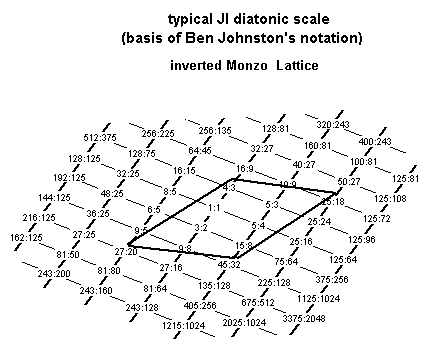Johnston notation
The system of notating rational intervals devised by American composer Ben Johnston (1926-2019). It evolved from the 1960s to the 1980s.
Johnston notation is based on the typical 5-limit JI diatonic C-major scale, represented by the seven letter-names ("nominals") A B C D E F G and corresponding to the respective ratios 5/3, 15/8, 1/1, 9/8, 5/4, 4/3, and 3/2. This scale is a periodicity-block as shown on the following lattice-diagram:

The accidental symbols # and b represent an alteration of intonation by the ratio 25:24 (= ~70.67 cents), plus or minus respectively.
The symbols + and - represent an alteration of intonation by the ratio 81:80 [= ~21.506 cents], which is the syntonic comma.
Each additional accidental in Johnston's system represents an intonational inflection resulting from the incorporation of additional prime-factors in the ratio of a given pitch.
Johnston notation uses arrows pointing up or down to represent the presence of prime-factor 11, and for all higher primes his notation simply uses the prime number itself for the otonal adjustment and the prime number inverted for the utonal adjustment.
It is the opinion of several tuning-theorists (including myself) that Johnston's notational concept is a good one, but that it could be improved by using as its basis a pythagorean C-major scale instead of the 5-limit one. See HEWM, and Monzo, JustMusic Prime-Factor Notation.
Reference
Fonville, John. 1991.
Perspectives of New Music, vol 29, no 2 [Summer], p 106-137.
Please make a donation to help keep Tonalsoft online.
Thank you!
